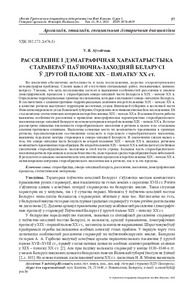Пожалуйста, используйте этот идентификатор, чтобы цитировать или ссылаться на этот ресурс:
https://elib.psu.by/handle/123456789/28606Полная запись метаданных
| Поле DC | Значение | Язык |
|---|---|---|
| dc.contributor.author | Аўсейчык, У. Я. | - |
| dc.contributor.author | Auseichyk, U. | - |
| dc.date.accessioned | 2022-01-18T07:03:23Z | - |
| dc.date.available | 2022-01-18T07:03:23Z | - |
| dc.date.issued | 2021 | - |
| dc.identifier.citation | Аўсейчык, У. Я. Рассяленне і дэмаграфічная характарыстыка старавераў паўночна-заходняй Беларусі ў другой палове XIX – пачатку XX ст. / У. Я. Аўсейчык // Веснік Гродзенскага дзяржаўнага ўніверсітэта імя Янкі Купалы. Серыя 1. Гісторыя і археалогія. Філасофія. Паліталогія. – 2021. – Т. 13, № 1. – С. 57-67. | ru_RU |
| dc.identifier.uri | https://elib.psu.by/handle/123456789/28606 | - |
| dc.description.abstract | Во введении обозначены актуальность и цель исследования, коротко охарактеризована историография проблемы. Сделан вывод об отсутствии специальных работ, посвященных данному вопросу. Указано, что цель исследования состоит в выявлении особенностей расселения и анализе демографических процессов у старообрядцев северо-западной части Беларуси в XIX – начале XX в. Определены территориальные границы исследования, которые охватывают северо-западную Беларусь. В соответствии с административно-территориальным делением второй половины XIX – начала XX в. в качестве региона выступают территории восточных уездов Виленской губернии и восточной части Новоалександровского уезда Ковенской губернии. Определена источниковедческая база исследования. Ей стал комплекс статистических материалов второй половины ХІХ – начала ХХ в. В основной части работы выявлены особенности расселения и приведена демографическая характеристика старообрядческого населения северо-западной Беларуси на основе материалов второй половины XIX – начала XX в. В статье рассмотрена динамика численности старообрядческого населения в регионе в целом и по отдельным административным единицам. Выделены основные места их компактного проживания в границах региона, проанализировано соотношение сельского и городского старообрядческого населения, выявлены городские центры староверов в северо-западной Беларуси. В заключении сделан вывод о том, что северо-западная часть Беларуси во второй половине ХІХ – начале ХХ в. являлась регионом компактного проживания старообрядцев. Во второй половине ХІХ – начале ХХ в. наблюдается устойчивое увеличение старообрядческого населения в этой части страны. Большая часть старообрядческого населения региона проживала в сельской местности, доля горожан среди старообрядцев была небольшой. В результате социально-экономических и политических процессов второй половины ХІХ – начала ХХ в. активизирована миграция старообрядческого населения как в регионе, так и за его пределы | ru_RU |
| dc.language.iso | be | ru_RU |
| dc.publisher | ГрГУ им. Янки Купалы | ru_RU |
| dc.title | Рассяленне і дэмаграфічная характарыстыка старавераў паўночна-заходняй Беларусі ў другой палове XIX – пачатку XX ст. | ru_RU |
| dc.title.alternative | Settlement and demographic characteristics of Old Believers of northwestern Belarus in the second half of the 19th and early 20th centuries | ru_RU |
| dc.type | Article | ru_RU |
| dc.identifier.udc | 392:273.2(476.5) | - |
| local.description.annotation | The introduction outlines the relevance and purpose of the survey and briefly describes the historiography of the problem. It concludes that there are no special works on this issue. It is pointed out that the aim of the study is to identify settlement features and analyze demographic processes among Old Believers in the north-western part of Belarus in the 19th and early 20th centuries. The territorial boundaries of the study, which cover northwestern Belarus, have been defined. In accordance with the administrative and territorial division of the second half of the 19th and early 20th centuries, the territories of the eastern counties of Vilnius Province and the eastern part of Novoalexandrovski County of Kovenski Province serve as a region. The source base for the study was determined. A set of statistical materials from the second half of the 19th and early 20th centuries has become available. In the main part of the work, the peculiarities of settlement have been identified and demographic characteristics of the Old Believers’ population of North-West Belarus have been given on the basis of materials of the second half of the 19th – early 20th centuries. The article deals with the dynamics of the Old Believers’ population in the region as a whole and by individual administrative units. It identifies the main places of their compact residence within the region, analyzes the ratio of rural to urban Old Believers, identified urban centers of Old Believers in north-western Belarus. The conclusion was drawn that the north-western part of Belarus in the second half of the 19th and early 20th centuries was a region of compact Old Believers’ residence. In the second half of the 19th and early 20th centuries, there was a steady increase in the Old Believers’ population in this part of the country. The majority of the Old Believers in the region lived in rural areas and the share of urban dwellers among Old Believers was small. As a result of socio-economic and political processes in the second half of the 19th and early 20th centuries, the migration of Old Believers both in the region and abroad is intensifying. | ru_RU |
| Располагается в коллекциях: | Публикации в изданиях Республики Беларусь | |
Файлы этого ресурса:
| Файл | Описание | Размер | Формат | |
|---|---|---|---|---|
| 57-67.pdf | 711.75 kB | Adobe PDF |  Просмотреть/Открыть |
Все ресурсы в архиве электронных ресурсов защищены авторским правом, все права сохранены.